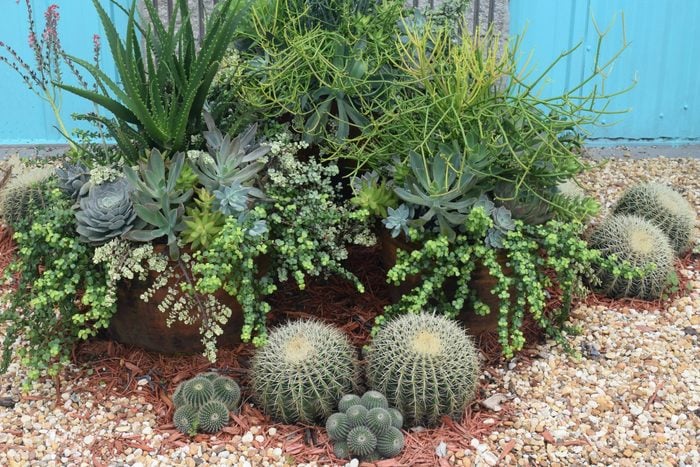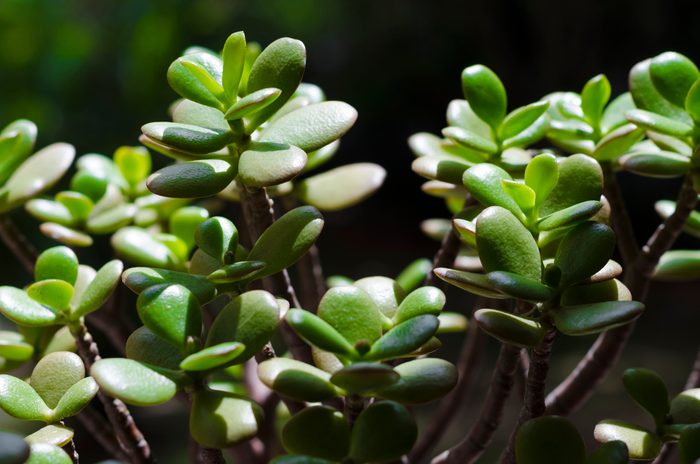
Gandalf
One of the newest members of the jade plant family, Crassula ovata ‘Gandalf’ is a cross between ‘Baby Jade’ and ‘Gollum’ cultivars. Add a Crassula ovata ‘Hobbit’ and you have a wonderful “Lord of the Rings” enthusiast’s succulent collection.
Grow in U.S. Department of Agriculture Plant Hardiness Zones 9 through 12 in full sun to partial shade, with minimal watering. Its glossy, cylindrical, bright-green leaves turn brilliant red in full sunlight. When the leaves turn ratty, cut them off with clean shears.
‘Gandalf’ resists verticillium wilt and produces white flowers in summer. But beware: Gandalf is toxic to children and animals.
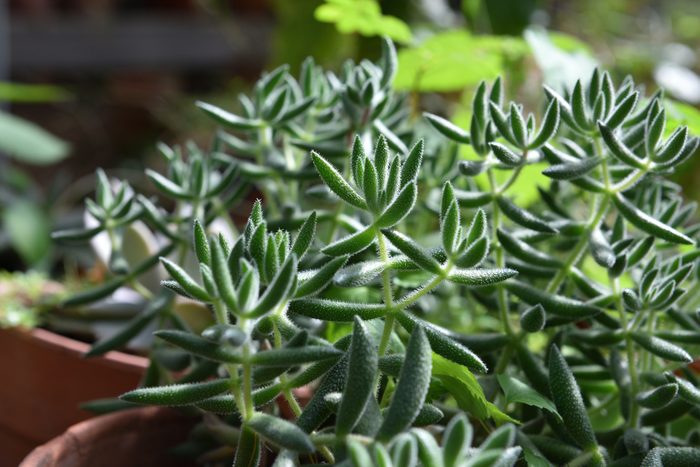
Tenelli
Native to South Africa, Crassula mesambryanthemoides ‘Tenelli’ grows in USDA Zones 9 through 12. Its soft bluish-gray elongated foliage looks fuzzy and feels like velvet. The young leaves grow angularly in all directions, and small red flowers appear in late summer to early fall.
As it matures into a 12-inch shrub, the foliage turns an attractive reddish and woody. ‘Tenelli’ needs full sun and water once every 12 to 14 days. This non-toxic succulent also propagates easily from leaf and stem cuttings.
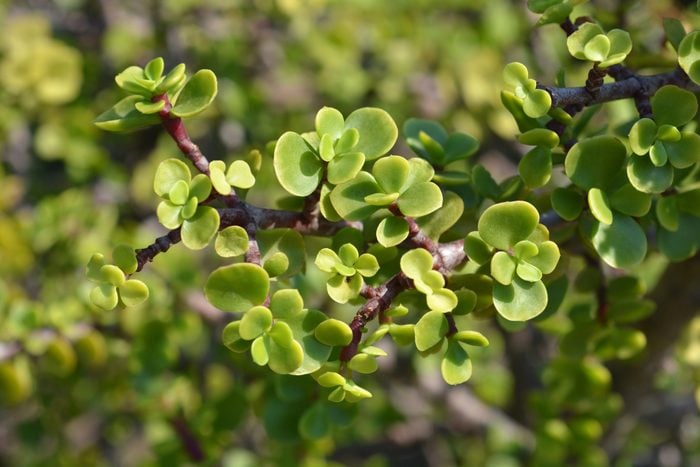
Elephant Bush Variegata
This unique succulent features creamy edges, light-green leaves and red stems. Known as the Elephant Bush because elephants love to eat it, this plant has been known to live for decades and reach 10 to 20 feet tall. In your succulent bed, it can mimic a miniature tree.
Look for it under its scientific name, Portulacaria afra ‘Vareigata.’ It grows in Zones 10 through 12 in partial sunlight, but it can’t handle cold winter temperatures or full Southern sun. This non-toxic succulent can produce lavender and pink flowers, though they’re rarely seen when grown outdoors. Don’t forget to check out this simple hack for cloning succulents.
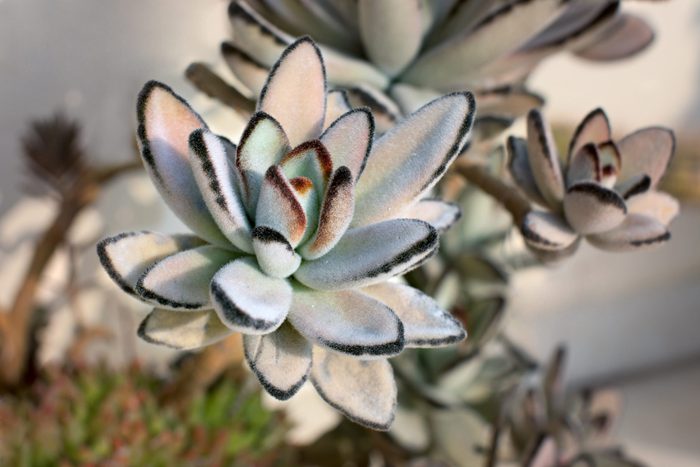
Chocolate Soldier
Another favorite succulent, the Kalanchoe tomentosa ‘Chocolate Soldier’ works in sensory gardens because of its fuzzy foliage. Tomentosa is Latin for “covered with densely matted wooly hairs.” The gray-green leaves are edged with brown spots that look like stitching, hence its popular name.
It’s also called ‘Donkey Ears,’ ‘Panda Bear,’ ‘Pussy Ears,’ and ‘Teddy Bear’ because it’s fun to touch. ‘Chocolate Soldier’ grows in partial sunlight in Zones 9 through 12. It develops woody stems and can reach a mature height of two and one-half-feet tall.
It’s rare to see flowers. But when burgundy-red flowers do bloom, it will be in spring and summer. Be careful if you have pets; Kalanchoe plants are toxic to cats and dogs.
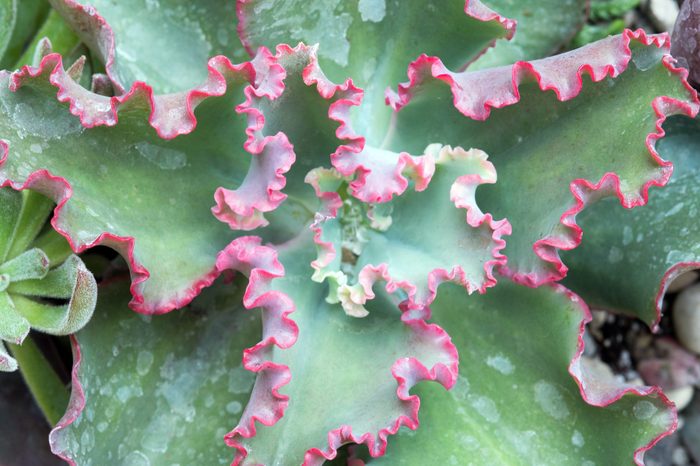
Dick’s Pink
One of the more unusual flowering succulents, Echeveria ‘Dick’s Pink’ grows in Zone 9 through12 and can handle winter temperatures down to 25 degrees.
‘Dick’s Pink’s sturdy, pink-edged, crinkled leaves grow above an elongated stem. In summer, these leaves will be more bluish, change to light purple in the fall. Tall, pink and reddish flowers that attract pollinators emerge on four- to five-inch stalks. It’s safe in children- and pet-friendly yards.
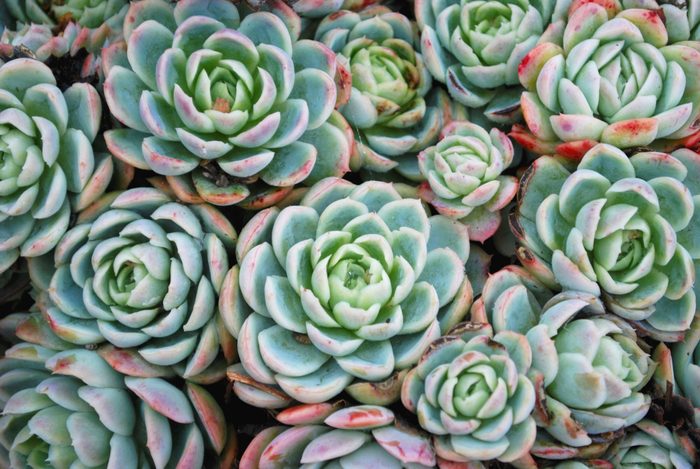
Pollux
One of the prettiest varieties, Echeveria ‘Pollux,’ will be the brightest star in your succulent garden. Reaching eight inches wide, it thrives outdoors in full sunlight to part shade. It loves the heat and doesn’t mind being mulched with stone or gravel.
The lovely silver-to-gray leaves radiate around its center, suggesting a Fibonacci spiral. Echeveria ‘Pollux’ grows in Zones 9 through 12 and can withstand low temperatures of 25 degrees. Like most succulents, non-toxic ‘Pollux’ can get by on one or two waterings per month. Reduce watering to once a month in winter to prevent rotting.
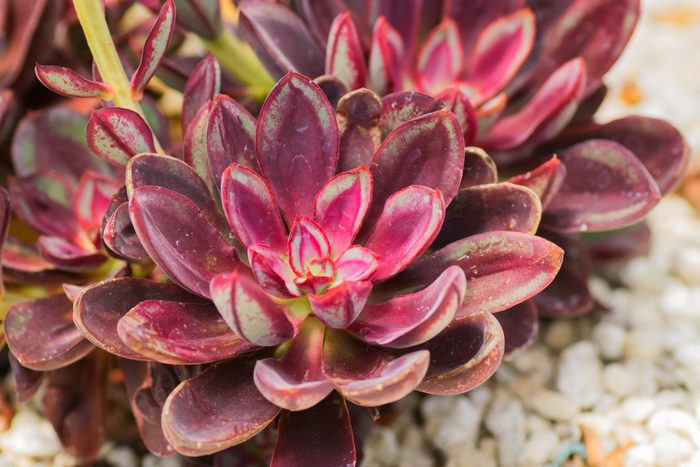
Nodulosa
You’ll first notice the vertical red, almost purple-lined foliage of this striking succulent. Native to Mexico, ‘Nodulosa’s common name is Painted Echeveria. The red markings on the leaves do evoke a look of quick, upward brush strokes. In summer, yellow and pink flowers on stalks hang two feet above the rosette, attracting hummingbirds.
Hardy to 30 degrees, grow this in full sun or partial shade in Zones 9 through 12 in well-drained sandy soil. Water when the soil feels dry to the touch. Non-toxic ‘Nodulosa’ grows to eight inches wide and reproduces easily.
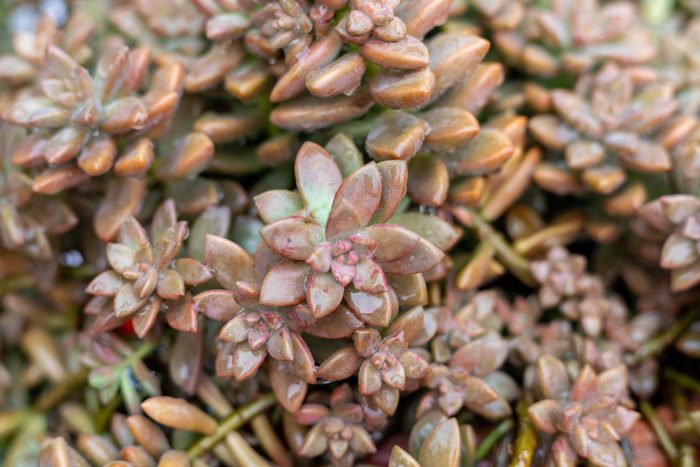
Ghosty
Graptosedum ‘Ghosty’s ethereal gray and pink foliage will accentuate any succulent garden. Resembling Echeverias, this species is a hybridization of two groups, Graptopetalum and Sedums.
There’s a difference between ‘Ghosty’ and ‘Ghost Plant,’ another popular Graptopetalum. Their flower color is the easiest way to tell them apart. ‘Ghost Plant’ flowers are yellow, while ‘Ghosty’s’ are white.
Grow in Zones 9 to 12, with full sun and good drainage, or Zones 7 through 8 with winter protection. One of the hardiest succulents, non-toxic ‘Ghosty’ can tolerate freezes down to 10 to 20 degrees.
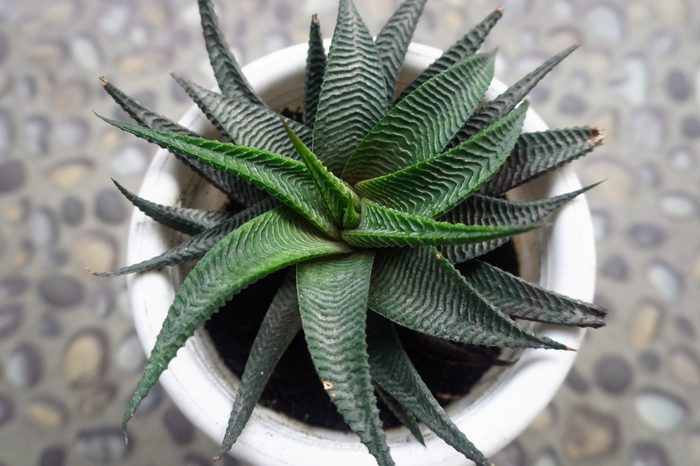
Fairy Washboard
Native to South Africa, Haworthia limifolia, aka Fairy Washboard, was discovered at the beginning of the 19th century. The magical name stems from the exciting tactile ridges on the leaves, which look like an old-time laundry washboard.
One of the smallest succulents on this list, non-toxic Fairy Washboard grows to four inches wide and two to three inches tall. Tubular white flowers emerge on an eight-inch stalk in late summer and fall. Hardy in Zones 10 through 12, it needs partial shade and dry soil. Water twice a week during spring and fall.
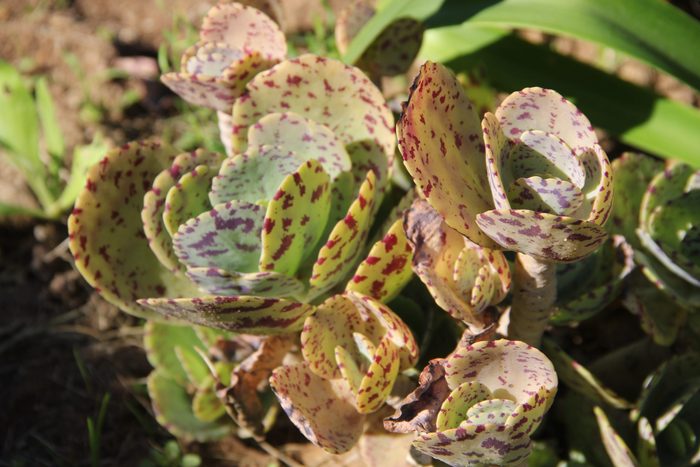
Marmorata
The Latin word ‘marmorata’ means encrusted or covered with marble. That perfectly describes the delicate yet bold purple veins covering the soft grayish-green leaves of Kalanchoe ‘Marmorata.’
Native to the Afrotropical climate of Central and West Africa, these beautiful succulents are more tender than others on this list. ‘Marmorata’ grows in Zones 10 through 11 in partial shade with freeze damage below 30 degrees. It can mature to four feet wide with leaves that can extend eight inches.
Unlike other succulents, ‘Marmorata’ requires adequate watering in the winter when it’s growing, rather than in the summertime when growth slows down. Its beauty shines in late winter through early spring, with pure white to light pink star-like flowers on 12-inch green stalks.
The Royal Horticultural Society gave this cultivar the Award of Garden Merit, but it’s toxic to children and pets.
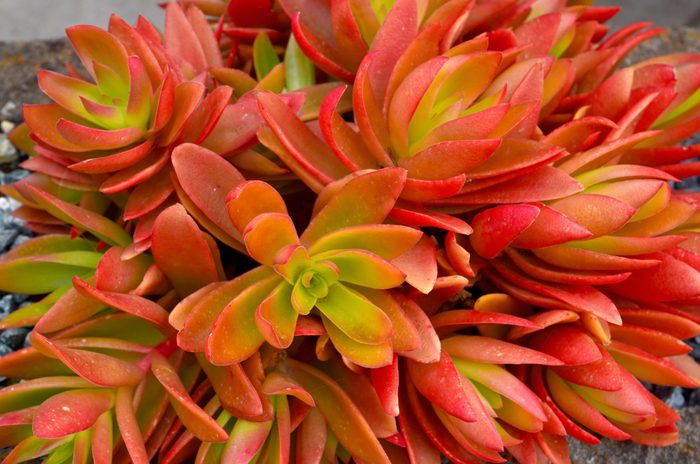
Adolphii
With common names ‘Golden Glow’ and ‘Golden Sedum,’ this bright and cheery little Sedum ‘Adolphii’ features banana-shaped green leaves that turn yellow, orange, and red. A fast grower in full sunlight in Zones 9 to 12, this Mexican native can be found naturalized in the Canary Islands and Sicily.
‘Adolphii’ will reach eight to 10 inches and quickly spread. This colorful plant is not only drought-tolerant but wind-resistant, making it an excellent choice for rock gardens. Plant in full sun with well-drained soil, and water only when soil is completely dry. Non-toxic ‘Adolphii’ produces fragrant white flowers that bloom in winter.
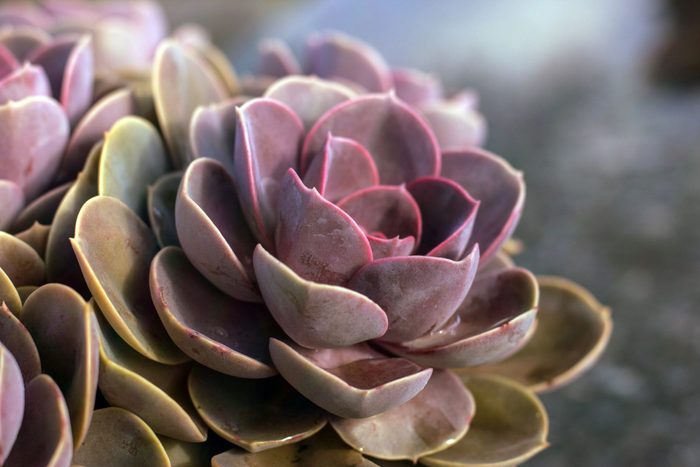
Metallica
If you’re thinking this succulent should be in the ‘hard rock’ category, you’d be wrong. The classic and elegant Echeveria perle ‘Metallica’ was first discovered and cultivated in Mexico in 1863. In the 1930s, Alfred Gräser, a German plant breeder, hybridized ‘Metallica’ with E. elegans and named the new cultivar ‘Perle von Nurnberg.’
The soft pink and purple iridescent foliage rosettes, smaller than other echeverias, turn blue in the shade. Non-toxic, it produces new plants easily, making it extremely popular among gardeners. Hardy to 25 degrees, grow ‘Metallica’ in full sun to partial shade in Zones 9 through 12. Allow soil to dry out completely before watering. It produces pink flowers in spring and summer.
The Royal Horticultural Society praised Gräser’s special cultivar by giving ‘Perle con Nurnberg’ the Award of Garden Merit.

